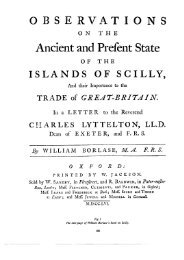Cornwall during the Iron Age and - Cornwall Archaeological Society
Cornwall during the Iron Age and - Cornwall Archaeological Society
Cornwall during the Iron Age and - Cornwall Archaeological Society
You also want an ePaper? Increase the reach of your titles
YUMPU automatically turns print PDFs into web optimized ePapers that Google loves.
a combination of all <strong>the</strong>se resources contributed to <strong>the</strong> position of hillfort-building chiefs.<br />
Material wealth, represented by archaeological finds, still seems to have been less than that<br />
evidenced elsewhere in Sou<strong>the</strong>rn Engl<strong>and</strong>, but perhaps has been underestimated. No new<br />
pieces of decorated metalwork have been found since 1958 although a study of <strong>the</strong> Trenoweth<br />
collar (Megaw, 1967) relocates its findspot to St Stephen-in-Brannel.<br />
The univallate hillslope fort of St Mawgan-in-Pydar (c. 1.2 ha) near Newquay (Threipl<strong>and</strong><br />
1956) hints at a different kind of social unit to those represented by rounds or multiple<br />
enclosure hillforts. Despite its small size, its entrance had an elaborate unturn, a feature<br />
lacking in rounds, <strong>and</strong> it produced a rich array of finds, including a decorated shield<br />
mounting. The date of occupation may have been from c. 100 BC to AD 100. Thus, unlike<br />
<strong>the</strong> multiple-enclosure hillforts, it continued after <strong>the</strong> Roman occupation.<br />
The dead of <strong>Iron</strong> <strong>Age</strong> <strong>Cornwall</strong> are less well represented than <strong>the</strong> living, yet compared<br />
to most of Britain <strong>the</strong> evidence is good. <strong>Cornwall</strong> is one of <strong>the</strong> few areas to have produced<br />
cemeteries. Those at Harlyn Bay <strong>and</strong> at nearby Trevone (Dudley, 1965) have long been<br />
known, as have <strong>the</strong> smaller sites at Trelan Bahow in <strong>the</strong> Lizard, Stamford Hill outside<br />
Plymouth <strong>and</strong> related sites in <strong>the</strong> Isles of Scilly. These sites are all dateable as graves have<br />
produced decorated metal artefacts, especially brooches <strong>and</strong> mirrors, ranging in date from<br />
<strong>the</strong> 3rd century BC to <strong>the</strong> 1st century AD. O<strong>the</strong>r cemeteries such as Crantock without<br />
dateable artefacts may also be of <strong>Iron</strong> <strong>Age</strong> date (Whimster, 1977, 81). Whimster's excavation<br />
at Harlyn Bay in 1975 showed that <strong>the</strong>re may have been a circular stone temple in <strong>the</strong> vicinity<br />
of <strong>the</strong> cemetery (1977, 69). Whimster's work at Harlyn Bay formed part of a major study<br />
of burial practices in <strong>Iron</strong> <strong>Age</strong> Britain (1977a, 181). He was able to demonstrate <strong>the</strong> regular<br />
pratice of crouched inhumation with head to <strong>the</strong> north in <strong>Cornwall</strong>, as in scattered burials<br />
across Wessex, <strong>and</strong> in <strong>the</strong> Yorkshire cemeteries which include 'chariot' burials. Until<br />
Whimster's study, <strong>the</strong> south-western cemeteries had been linked to those in Brittany because<br />
of <strong>the</strong> presence of long stone cists in both areas. But in Brittany <strong>the</strong> burial rite was extended<br />
inhumation. The Cornish cemeteries seem to be showing us a British funerary tradition made<br />
archaeologically visible by <strong>the</strong> use of long stone cists. Whe<strong>the</strong>r <strong>the</strong> stone cists, using local<br />
slate, reflect Breton influence, is an unanswerable question at present. It must be doubtful<br />
whe<strong>the</strong>r <strong>the</strong>re was any Breton influence on <strong>the</strong> religious practices of <strong>Iron</strong> <strong>Age</strong> <strong>Cornwall</strong>. The<br />
Breton evidence, conveniently summarized in Giot (1960), emphasises <strong>the</strong> importance of<br />
carved stone pillars (lec'hs). None have ever been noted in <strong>Cornwall</strong>, despite <strong>the</strong> present<br />
author's hopeful examination of st<strong>and</strong>ing stones over <strong>the</strong> past fifteen years.<br />
Both religious practices <strong>and</strong> Breton connections enter consideration of <strong>the</strong> souterrains or<br />
logous' of West <strong>Cornwall</strong>. A useful factual summary was published by Clark in 1961.<br />
Cornish souterrains differ from <strong>the</strong>ir Breton counterparts in <strong>the</strong>ir method of construction.<br />
They are constructed of stone in open trenches, whereas Breton soutterains are entirely tunnelled<br />
out; in this respect Cornish examples are similar to those in Scotl<strong>and</strong> <strong>and</strong> in Irel<strong>and</strong>.<br />
It is becoming increasingly aparent that souterrains in all <strong>the</strong>se areas are closely linked to<br />
settlements <strong>and</strong> are not isolated monuments. Thomas (1972) argued that souterrains were<br />
used for storage, drawing on <strong>the</strong> similarities with <strong>the</strong> medieval <strong>and</strong> later West Cornish 'hulls',<br />
a point also brought out in a comprehensive survey of hulls by Tangye (1973). A throughdraught<br />
may have been provided by small gaps in <strong>the</strong> end opposite <strong>the</strong> entrance, or in <strong>the</strong><br />
side passage.<br />
A detailed examination of <strong>the</strong> Cam Euny fogou <strong>and</strong> associated 'round chamber' was<br />
carried out by Christie (1978) <strong>during</strong> <strong>the</strong> 1964-72 excavation programme. The 'round<br />
chamber' with a short entrance passage proved to be <strong>the</strong> earliest feature of <strong>the</strong> complex; it<br />
was thought ei<strong>the</strong>r to have had a timber roof or to have remained open. A stamped-decorated<br />
sherd similar to those found in a feature elsewhere on <strong>the</strong> site with a radiocarbon date of<br />
118




